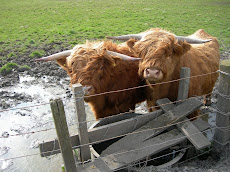Fortified Farmhouses Built for Defence Against the Border Reivers
People of the English\Scottish Borderline lived in constant fear of raid and reprisal at the hands of the Border Reivers (Robbers). The Bastle House provided refuge and defence.
In the 14th, 15th and 16th centuries the country on each side of the English Scottish Border was the haunt of the Border Reivers. Initially through desperation in their dire want, reluctantly embroiled as they were in the Scottish Wars of Independence, they began to steal cattle and sheep where they could. There was little alternative as time on time all they owned was robbed to service an army on the move, destroyed or burned for no other reason than they belonged to the enemy. In time their dubious calling became a way of life with an outcome of family and clan feud which spanned generation after generation. Within a very short time the Border folk knew no other way of life in an area where authority and government demonstrated little control nor provided succour or aid in a land where the Border folk were caught in the middle of the relentless, fierce and aggressive surge for dominance between England and Scotland.
The Bastle House Comes into its Own
By the middle of the 16th century the whole of the Border region was in turmoil. The reiving had escalated to a point where feud between the Border clans was rife and theft and murder were every day occurrences. Throughout the Borders fortified towers of immense strength, known as Pele Towers, became the strongholds of the Clan or family chief. These provided refuge not just for the Chief's family but also all those who depended upon him; his family or clan. At the same time, a less expensive way of providing fortified shelter became common. This was known as a 'Bastle' house and was in effect a farmhouse built to withstand attack and provide shelter for man and beast alike. The word comes from the French 'bastille', a fortress. The bastle was a true product of its time and is to be found predominantly on the English side of the Border. Why? Probably because during the last half of the sixteenth century Scots incursions into England, or at least the threat of them, far outweighed raids in the opposite direction.
The Bastle is Built with Defence in Mind
The stones used to build the bastles were massive yet often they contained no mortar which was a material few men could source or afford. Rather the stones were held together with wedge-shaped off-cuts of those stones that were dressed. This practice was known as 'galletting', a procedure which has stood the test of time as witnessed by the many bastles that still stand in partial ruin to this day. The roof tiles were made of heavy stone which were impossible to set on fire and held together with the bones of sheep. Often, but certainly not always, the bastle had a vaulted basement as seen in the Pele Tower accessed by two doors, an iron one known as a 'yett' and a heavy oaken studded door as further defence. The vaulted ceiling of the basement had a trapdoor which accessed the living quarters on the floor above. The most valuable beasts including any horse would be quickly led into the vault in times of attack after which the inmate would access the living quarters by means of the trap-door. The ladder he used to achieve this would be drawn up behind him into the living space before the trap-door was slammed shut and bolted. The walls of the bastle could be up to three feet thick.
Access to the Living Quarters
Apart from the door into the vault there was no other means of access to the building at ground level. Instead entry into the living quarters, the second floor, was by means of a ladder to a door placed high in the long wall of the house which, again, was drawn up behind the owner should a raid be imminent. Any reiver, bent on stealing the beasts or confronting the householders would be hard pressed to achieve his aim. The owner's neighbours would soon come to his aid should he be able to hold off the initial attack. The living room of the bastle, built along the lines of the far superior Pele Tower, contained the usual massive fireplace, was spacious and open but, at night, was used for makeshift bedrooms as well.
In the present day Northumberland and Cumbria there are many fine examples of the bastle house which have been renovated and are lived in. Those at 'Towhouse' near Haltwhistle and the 'Hole' near Bellingham in Northumberland are truly awesome in their obvious strength and brooding defiance against attack whilst the Alston area of Cumbria boasts a host, from those that are in pristine condition, to others in various stages of dilapidation. There are others still to be seen in the Bewcastle area of Cumbria and many huddled together and still in use in the village of Chesterwood in Northumberland.
Once the homes of a people who lived in fear of the next raid coming screaming over the horizon in the dead of night, they all bear testimony to a more violent age.
Since the day I learned to read I have been passionately interested in history; all history, all places and all people. Naturally, being English, I have an affinity with British history as its heritage is within relatively easy reach. In 1985 I moved with my job to the Scottish Borders and fell in love with the place. There it was a surprise to find out that I knew nothing of the Border Reivers, the lawless clans who held sway in the Border country for centuries. I found their history to be absorbing and fascinating and today, twenty-five years later, the enthusiasm and passion shows no sign of waning. I am a fully qualified textile technologist and am often asked how I equate an interest in history with a profession that encompasses the physical and chemical properties of yarns and cloth and machinery precision. Strange bedfellows indeed! I find my outside interest in history to be a perfect foil to my work and consider myself blessed that I have a passion in both camps. I have written a book about the most infamous Scottish Border Reiver of the 16th century. He was known as Kinmont Willie Armstrong. The Book is called 'Deadlock and Deliverance'. Currently I am writing yet another book about the Northern Rebellion of 1569/70 which involved the Scottish Border Reivers. http://www.reivershistory.co.uk
Article Source: http://EzineArticles.com/?expert=Tom_W_Moss
Tom W Moss - EzineArticles Expert Author
Subscribe to:
Post Comments (Atom)











No comments:
Post a Comment